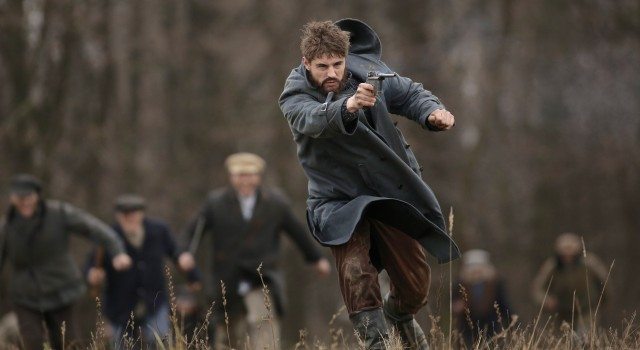

Bitter Harvest opens with the rippling wheat fields of Ukraine. Our hero, Yuri, narrates a childhood which doubles as a visual mainline of Ukrainian tradition, imagery, and cultural nostalgia. Yuri grows into a lovelorn artist played by Max Irons who is gently but consistently refused by his childhood sweetheart, Natalka (Samantha Barks, Les Misérables). There are many embroidered blouses, and there is much traditional carousing.
Because it precipitates an inevitable Edenic fall, we can maybe excuse the exposition for its floweriness. Yuri’s friends are gearing up to go to Ukraine’s capital, Kyiv, where there is promise of change and modernization. Meanwhile, Soviet agents with ubiquitous leather trench coats start to move in on the independent small farmers, demanding that they join the Soviet collectivization system. Yuri and Natalka get together despite her reservations, but Yuri heads to the capital alone to study art and wait for her. Their reunion becomes increasingly impossible as the political situation heats up — Yuri’s art is not sufficiently doctrinaire, communist infighting is threatening his friends, and Stalin orders the forced farm collectivization to deliberately starve the resistant Ukrainian farmers.
The famine that resulted from Stalin’s policy is called the Holodomor (meaning hunger-plague in Ukrainian), killing uncounted millions of Ukrainians. That it was a matter of deliberate policy, as represented here, is supported by prominent, respected historians, but the insidious quality of Stalin’s atrocities are their lack of systematic records (versus the horrific bureaucratic quality of the Holocaust). A lasting sense of ambiguity promotes continued ignorance to the atrocity. Director, writer, and producer George Mendeluk is admirable for the attempt itself to make the Holodomor an element of popular history.
But I wish Mendeluk had had a better editor. The plot is bulky, with many needless, unresolved conflicts. Why does Natalka resist marriage? Why is there a treasured saber and icon? Why is Yuri’s friend in love with Natalka? Some of the bulkiness is not Mendeluk’s fault. The movie has to do a lot of contextualizing and general cultural primers to tell Ukraine’s story. Where other mid-century atrocities have whole movie genres devoted to them, Mendeluk has no such foundation to work with.
Still, maybe he could have done less plot and more evocation. I don’t claim to have special authority on this period, but I am the descendent of a survivor. My knowledge of the event comes from brief, traumatic anecdotes. Episodes with little context and no dramatic continuity. A sister that laid in front of the fire as though to sleep, who never rose. Crops doused in gasoline, ravenously eaten. I found that was all I needed.
I hope in seeing this that, yes, people take some time to familiarize themselves with Ukraine’s culture and the many millions that perished under Stalin. But also realize that the present hardly compares favorably to the past -- except that we took in refugees like my family back then.